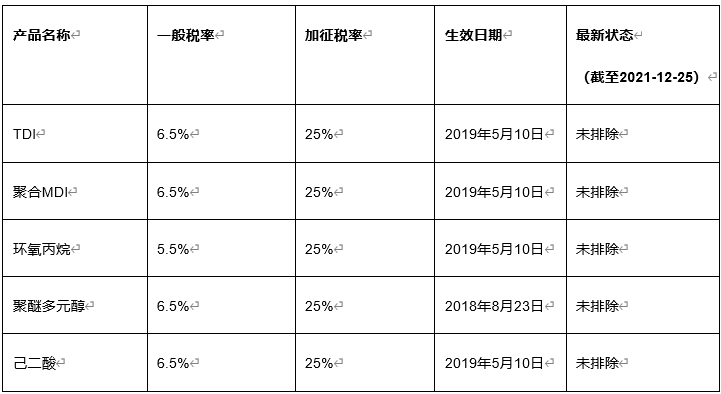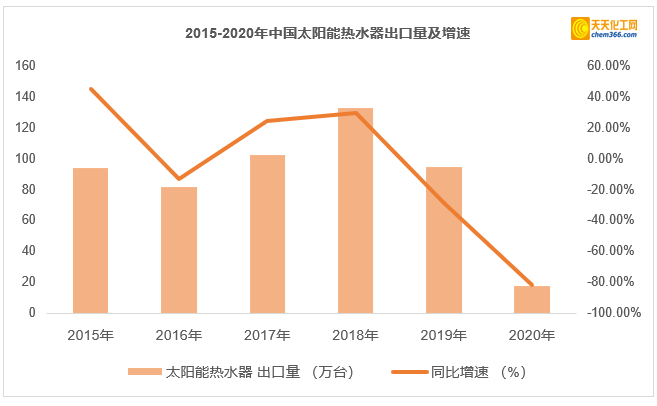On March 23, 2022 local time, the Office of the United States Trade Representative (USTR) issued a statement announcing the re-exemption of tariffs on 352 items imported from China. The new rules will apply to goods imported from China between October 12, 2021 and December 31, 2022. The office stated that the US decision on the day was the result of a comprehensive solicitation of public opinions and consultations with relevant US agencies.

The United States is highly dependent on China for the goods that have been granted tariff exemption restoration. Based on the proportion of U.S. imports from China to U.S. imports from the world, 27.6% of the goods granted exemption extension, Although it is lower than the non-tariffed goods (84.0%), it is higher than the overall (17.7%) and 352 other than the tariffed goods (9.7%).

Source: U.S. Department of Commerce Census Bureau, data as of January 2022
Concern 1: Are polyurethane raw materials included in this exemption list?
In the exemption list announced by USTR this time, it is found that: Polyurethane raw materials such as TDI, polymeric MDI, propylene oxide and polyether are not included in this time In the tariff list for re-exemption of imported goods, as of the publication of the article, the results of the query on the tax rate query website by the editor of Tiantian Chemical Network still show the status of “not excluded”. (See the table below for details: The United States imposes additional regulations on PU raw materials imported from China Tariff collection table)

Note: The tax rate query website is Customs Xiaoer, organized by Tiantian Chemical Network.
Concern 2: Are polyurethane products and related downstream products included in the exemption list?
The amount of goods that have been granted tariff exemption restoration in this exemption list: Electrical equipment, mechanical appliances, and furniture are awarded the top three in the amount of tariff exemption restoration , 22.1, 9.2, and 7.8 billion U.S. dollars, respectively, and the pass rates of tariff exemption restoration were 96%, 71%, and 76% respectively.

Source: USTR, U.S. Department of Commerce Census Bureau, CICC Research Department
In terms of further subdivision, those related to polyurethane and downstream industries mainly cover the following items:
- Polyurethane material: Molded polyurethane (polyurethane) molding

- Polyurethane downstream industry: Solar water heaters

According to relevant industry data, from 2015 to 2017, China’s annual export volume of solar water heaters was around 800,000 to 1 million units. In 2018, it reached a peak of 1.35 million units in recent years, and the export volume declined significantly in 2019-2020. The news of this tariff exemption is good for the export competitiveness of domestic solar water heater manufacturers.

Summary:
In the past two years, although the United States has imposed a large number of tariffs on China, the trade volume between China and the United States has increased instead of falling.
According to data from the General Administration of Customs of China, in the first half of 2021, the total value of bilateral trade in goods between China and the United States was 2.21 trillion yuan, a year-on-year increase of 34.6%. Exports to the United States were 1.64 trillion yuan, an increase of 31.7%, of which labor-intensive products exported 372.2 billion yuan, an increase of 24.1%. In terms of specific products, computers, mobile phones, home appliances, clothing, plastic products, and furniture all maintained growth. This is mainly because the US government is sensitive to high inflation in the country, so it tends to exempt consumer goods that are mostly used by civilians.
In response to the U.S. announcement to resume tariff exemptions for 352 items imported from China, Chinese Ministry of Commerce spokesperson Shu Jueting said at a regular press conference on March 24, This contributes to the normal trade of related goods. “China always believes that the unilateral tariff increase by the United States is not good for China, not good for the United States, not good for the world. In the current inflation Under the situation of rising prices and challenges to global economic recovery, it is hoped that the United States will proceed from the fundamental interests of consumers and producers in China and the United States, cancel all tariffs on China as soon as possible, and promote bilateral economic and trade relations.day back to normal. “And this will also help China’s polyurethane and its downstream products (such as solar water heaters, etc.) to return to the normal trade track between China and the United States.



 微信扫一扫打赏
微信扫一扫打赏
